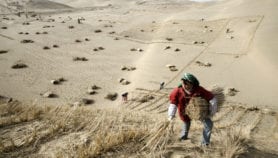By: Saleem Shaikh
Send to a friend
The details you provide on this page will not be used to send unsolicited email, and will not be sold to a 3rd party. See privacy policy.
[ISLAMABAD] Using a mix of trees and crop species can help rejuvenate Pakistan’s deteriorating forests, a study reported.
The study is based on physical and chemical analyses of 400 soil samples, collected during a survey of farms and plantations to compare the four agro-ecological zones of the Punjab province.
Results of the findings published in the African Science Journal of Environmental Sciences and Technology (November 2011) will aid farmers to select the best possible trees and plants.
As the demand for food grains steadily increases, unused cultivable lands are being brought under crops in Pakistan and lands cannot be spared for planting trees.
Agro-forestry is a viable solution to this problem, where farms can grow trees alongside crops, Syed Muhammad Akmal Rahim, lead author of the study and divisional forest officer at the Punjab forest department in Lahore, told SciDev.Net.
Deputy Inspector-General of forests in the environment wing of the Pakistan Planning Commission, Shahzad Jehangir, believes that farmers will take interest in agro-forestry only if they are convinced of its economic benefits.
According to the Food and Agriculture Organisation (FAO) ‘s State of the World Forests 2011 report, Pakistan has only two per cent of its area under forest cover. But government officials estimate the current forest cover at around five per cent.
The Pakistani government has a target of increasing forest cover to six per cent by 2015, according to World Wide Fund-Pakistan’s Conversion of Forests to Non-Forestry Uses in Pakistan 2010 study.
But it is difficult to achieve that target given the country’s negative forest growth.
Jehangir said unchecked tree-felling, degradation and encroachment of natural forest lands and rangelands, conversion of forest lands to non-forestry uses, galloping population, inadequate alternative energy sources, urbanisation and poverty are major problems.
"However, countering these challenges is possible with sufficient financial resources allocation, the latest research facilities, imparting forest officials adequate training, technical and scientific know-how and banning tree-cutting and forest land conversion," he said.
Director-General of the Pakistan Forest Institute, Syed Badshah Bukhari, said that joint international and regional research and capacity-building programmes have been launched in partnership with FAO, the UN Environmental Programme, International Union of Conservation for Nature and the International Centre for Integrated Mountain Development.
Funds from the South Asian Association for Regional Cooperation are also being tapped to boost forest cover.
Bukhari said Pakistan has actively engaged in United Nations Reducing Emissions from Deforestation and Forest Degradation, or REDD+, process and long-term viable projects have been implemented with financial and technical help from the Global Environment Facility.
Link to African Science Journal of Environmental Sciences and Technology ![]() [449kB]
[449kB]
More on Desert science
News
Climate change can dry south Indian river, says new study
[NEW DELHI] Climate change could lead to huge01/03/12
News
Pakistan seeks tech fix for impending water crisis
[KARACHI] Pakistan is seeking technological solutions for an unfolding01/08/11
News
South Asia News in brief: 1–15 March 2008
Below is a round-up of news from or about South Asia for the period 1–15 March.20/03/08
News
Soil degradation issues ‘swept aside’, say experts
Soil scientists have called for more targeted research and strict guidelines to stop what they say is the m ...07/09/07
News
UN: Policymakers must rethink desertification
[BEIJING] A new policy report from the United Nations University (UNU) urges governments to adopt a more co ...28/06/07
News
Islamic fund created to secure food in Niger
A group of Islamic states have approved a five-year US$370 million fund to help combat desertification and ...19/06/07
News
Local people ‘vital to preventing desertification’
Integrating the livelihoods of local people into environmental management can help prevent the desertificat ...14/05/07
News
Forced migration key issue at desert meeting
Desertification could create more than 135 million refugees, as droughts become more frequent and climate c ...15/12/06





